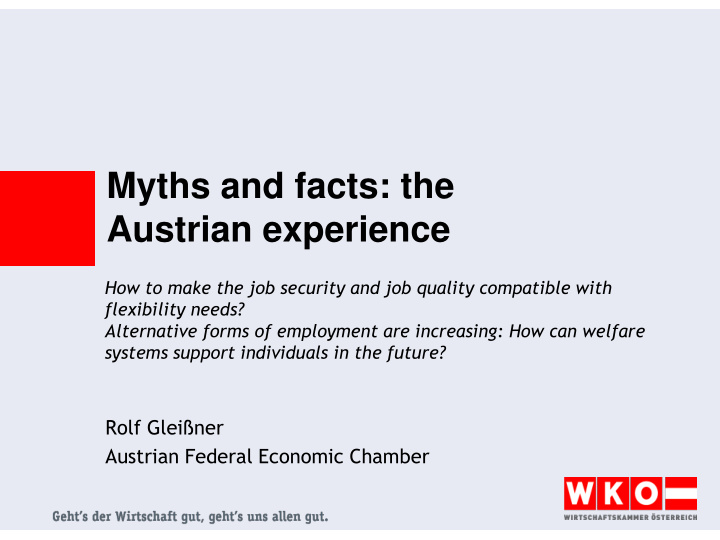



Myths and facts: the Austrian experience How to make the job security and job quality compatible with flexibility needs? Alternative forms of employment are increasing: How can welfare systems support individuals in the future? Rolf Gleißner Austrian Federal Economic Chamber
Do non-standard forms of employment increase in Austria? 24,0% 24,4% 24,8% 26,0% 29,5% 4,6% 3,7% 4,4% 3,1% 3,9% inactive 8,4% 8,6% 8,5% 8,8% 8,0% unemployed 7,0% 7,3% 7,7% 7,7% self-employed, entrepreneurs 7,5% free lancers 14,2% 16,2% 12,3% 15,6% 10,4% public servants employed, part time employed, full time 40,7% 39,5% 40,0% 39,0% 39,3% ´04 ´08 ´12 ´15 ´16 Statistics Austria, Austrian Labour Force Survey
Do non-standard forms of employment increase in the EU? Precarious Employment in Europe, European Parliament (2016) p. 31 „ The only main category of non-standard employment that has grown since the recession is part-time work .“ Eurofound: Non-standard forms of employment: Recent trends and future prospects (2017), p.19
Atypical = precarious = poor? At risk of poverty in Austria: total 14%, part-time 11%, unemployed 38% (EU-SILC 2016) “In -work poverty is strongly associated not so much with low pay as with single-earnership and low work intensity at the household level.. .“ „ No noticeable rising trend in in-work poverty since 2000.“ (Precarious Employment, EP, p. 67, 68) What triggers poverty? (Source: OECD 2008) Family Fewer Public Capital + Unidenti- structure workers Earnings transfers other incomes fied OECD 30.6% 5.8% 13.1% 12.0% 5.9% 32.6% - 17 private factors and unemployment are more important than non-standard employment
Is part-time precarious? „Open -ended full-time contracts and open-ended part-time contracts are at a relatively low risk of precariousness .“ “However , the risk of precariousness for marginal and involuntary part-time workers is of a relatively medium level .“ Precarious Employment, EP, p.11, 70
When jobs are lacking, many people work part- time involuntarily (cf. Eurofound, p.10)
Part-time employment in Austria Share 1992 12.6%, 2002 18.9%, 2016 27.8% that way reduction of average working time, which relieves the labour market, because it is agreed, not imposed! Part-time 87% voluntary; demand much higher than supply due to many incentives: - exemption from income tax and social contributions - subsidized part time models - social transfers are not paid above a certain threshold of income - lack of childcare facilities
Marginal part-time employment in Austria Limit € 415 per month share compared to standard employment 1997 5.4% 2008 8.1% 2016 9.6% Reasons for boom: - no social security contributions, no payroll tax - goes together with unemployment benefits, early retirement, childcare allowance, scholarships Study from 2012: high satisfaction, 80% do not want a standard working relationship; partly problematic! Part-time work is in demand because the state makes part-time attractive!
Social protection of atypical forms in Austria compulsory social insurance for all forms also applies to self-employed; even insured against unemployment, if they were formerly employees freelancers are equal to employees in social law BUT: labour law, collective agreements and minimum wages apply only to employees (incl. part-time + temporary work) principle of flexicurity 85% of self-employed in Austria are satisfied
Non-standard employment & labour market Atypical forms often provide the flexibility that is lacking in normal employment relationships, e.g. concerning working time in Austria – trade-off. "There's no better way to get people who have a hard time getting it into work than temporary work." Wolfgang Clement, German Minister of Labor and Economics 2002 – 2005 "The foundation for the German Employment Miracle was laid, among other things, by flexible forms of employment and moderation of wages." Christoph M. Schmidt, Chairman of the German Council of Economic Experts
Conclusion non-standard employment raises employment non-voluntary part time is reduced, if unemployment is reduced more flexible employment regulation reduces the attractiveness of non-standard forms Flexicurity is an option A range of forms corresponds to a diverse economy and society. rolf.gleissner@wko.at
Recommend
More recommend